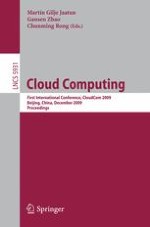This book constitutes the reviewed proceedings of the first International Conference on Cloud Computing, CloudCom 2009, held in Beijing, China, December 1-4, 2009. The 42 full papers presented together with four invited papers were carefully selected from 200 submissions. This book includes but are not limited to deal with topics like cloud /grid architecture, load balancing, optimal deploy configuration, consistency models, virtualization technologies, middleware frameworks, software as a Service (SaaS), hardware as a Service (HaaS), data grid & semantic web, web services, security and Risk, fault tolerance and reliability, auditing, monitoring and scheduling, utility computing, high-performance computing and peer to peer computing.
